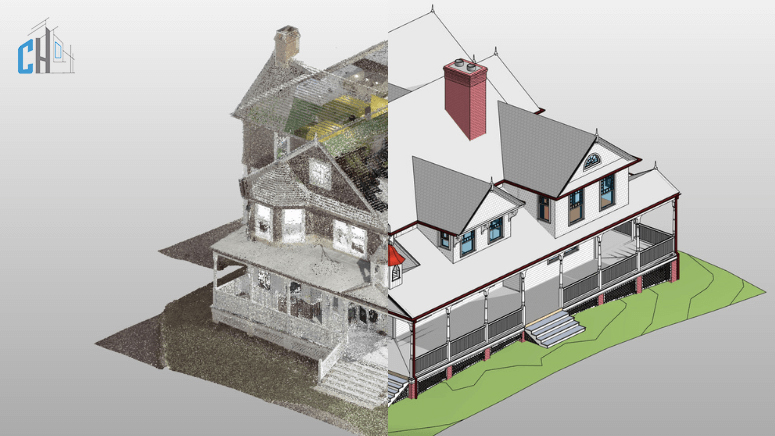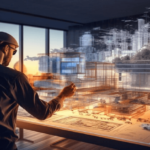Scan to BIM (Building Information Modeling) is a process used in the construction industry to create accurate 3D models of existing buildings or structures. The architecture and construction field has reached a technological threshold from which the processes can revolutionize precision, efficiency, and project improvement.
The scan to BIM or the Building Information Modeling could be a secret ingredient to achieving new heights for your architectural projects. For those who still don’t know what’s Scan to BIM, we should point out that it is a revolution within the BIM workflow that involves three-dimensional digitization of buildings through laser scanning and converting the resulting data into BIM representation in BIM software.
If you are an architect, BIM specialist, or construction manager charged with raising knowledge and applying this technology, you’re in the right place.
Understand the evolution of Scan to BIM
However, before going down to the details, it is essential to comprehend the underlying mechanism of Scan to BIM and Convert Point Clouds to Revit.
Realizing these possibilities has amplified the details and accuracy of on-site modeling, closing this gap between the physical and digital environments. Where TVs have shown, in sci-fi worlds, what used to be the space age is now a vital tool for construction and architecture professionals.
What is Scan to BIM?
Scan to BIM is a process of creating 3D building models development based on data gathered by advanced high-resolution surveying works.
This data called point cloud is the set of data points in a three-dimensional coordinate system representing the exterior of the object in this three-dimensional system. It essentially involves three main steps: classify, extract, and simulate.
Why is Laser Scanning in Construction Important?
The use of laser scanning technology in construction has become crucial, as it has the capability of acquiring vast amounts of data and very precise within a short time. This serves so that the end product can be likened to the original plan. down to the finest detail, eliminating the chances of errors and rework.
Problems Solved using Laser Scanning in the Construction Process
Conventional measurement and record-keeping procedures sometimes involve mistakes and occupy much time. These problems are brought to the forefront by laser scanning, which takes a trustworthy and prompt data-gathering method, ensuring an actual architecture and speeding up the processes.
Benefits of the scan to BIM
The advantages of Scan to BIM are not only revolutionary but also have many valuable things for architects, builders, and managers who want to improve their projects.
The precise nature of design and construction.
Perhaps the greatest strength of the process is the precision obtained in the scanning phase. It gives exact, highly detailed information on an existing building, which leads to minimizing the mistakes that can be made on the construction site.
Time and Cost Efficiency
The saving time and cost that arises from the fact that it does not require manual measurements and possible rework as a result of inaccuracies Scan to BIM offers make it preferable. Through projects that are delivered with quality and on time, clients have more confidence.
Enhanced Collaboration and Communication
Through the use of scanning, a 3D BIM model can be developed. The sharing and comprehension of the model are uncomplicated, even by those who are not designers or engineers.
This level of visualization increases collaboration, so decisions can be made better and the information can be shared among all stakeholders of the project during the whole lifecycle of the project.
Also read: Streamline your projects and save costs with BIM outsourcing. Contact us today!
Navigating the Process of Scan to BIM
A step-by-step guide on scanning the as-built conditions to creating a Building Information Model.
Understanding the Scan to BIM process in a nutshell, the sequence of the steps and the implied skills is the critical point.
Data Capture Using Scanning Technology Equipment
High-definition tech survey, like laser scan in SC is used to transmit spatial data in the form of point clouds. From this data, the basis of the 3D model is extracted and is the starting point of the Scan to BIM process.
Conversion and Modeling in BIM Application
The point cloud data is converted to a 3D model by means of a specialised software program. In the course of this very demanding process, the program generates geometric shapes, which are spelled out by the points available in the scan.
Integration with Existing Project
The 3D model fits into the existing BIM workflow, which means it becomes a part of the design process. This rules out that changes to the project plan in the form of drawings, schedules, and other design documentation will be taken into account for the as-built project site conditions.
Applications in Architecture and Construction
Scan to BIM flexibility makes it suitable for construction and architecture endeavors in different areas.
Renovation and Retrofit Projects
One of the utility of Scan to BIM for projects that require modification or addition to the existing structures is the providing of essential information about the current conditions that help in the planning and successful completion of the projects.
Clash Detection and Coordination
The 3D design models created are used in the clash detection step. Clash detection detects and resolves clashes between 2 or more objects with the same virtual space, before they become constructional issues and waste money.
As-Built Documentation and Facility Management
Scan to BIM as-built documentation supplied by Scan to BIM significantly contributes to facility management tasks beyond the construction phase, enabling clearer maintenance and operational planning, for instance.
Challenges and Considerations for Successful Scan to BIM Implementation
Although the gains may be plentiful, obstacles are also some of the challenges in the fast-track implementation of Scan to BIM.
Data Quality and Reliability Control
The accuracy of the scanned information and the ensuing 3D model stands as the crucial point of the entire model. The structure for quality checks must be developed with the aim of validating the validity of the data as well as being able to monitor the precision of the model.
Software Compatibility and Training
The team’s ability to use these scanning instrumentation and BIM software programs is highly pertinent in this case. It is imperative to conduct regular training sessions and continual learning programs to ensure proficiency and if something new has been developed later.
Legal and Privacy Considerations
The collection of the data by scans causes legal, and privacy problems to appear at most critical or bearer areas like train stations, underground passages etc. The involvement of personal data and images is a legitimate intrusion into privacy, and it’s imperative to consider and obtain permissions before any scrutiny begins.
Reasons to opt for Chudasama Outsourcing for Scan to BIM Services
CAD Drafting stands out as a leading provider of Scan to BIM services, offering unparalleled expertise and technology to architects, engineers, and construction professionals. Here are reasons why choosing CAD drafting company for your Scan to BIM needs is a discerning decision:
Expert Team with Specialized Experience
CAD Drafting dedicated BIM team of professionals are proficient in outclassing the scan to BIM services. This squad has the advantage of technical skills along with practical experiences which helps them to handle all architectural sorts of projects irrespective of the scale and complexity perfectly.
Customer-Centric Approach
Recognizing the specific needs of each project, CAD Drafting focused on a customer-specific approach, designing their Services according to the client’s requirements. This flexibility and responsiveness to client demands and suggestions result in doing work of the highest quality and meeting all customers’ expectations.
Competitive Pricing and Quick Turnaround
Despite it being the best services provider in its sector, CAD Drafting has an edge on the price side. Yet high quality with the guaranteed meeting of deadlines is not the only thing they provide: they give an unshakable value proposition to clients who want to wring the dry squeak out of their projects without compromising the quality or the deadlines.
Now, when you enlist your Scan to BIM needs for CAD Drafting, you enjoy individuality just because you are now leaning on consulting, technology, and customer-oriented superservice convenience that will most likely lead to success.
Conclusion
Finally, Scan to BIM is a lot more than just a spoken phrase in architecture and construction projects. It is indeed a revolutionary way, and it comes with significant benefits and drawbacks along with a lot of aspects of its application that need to be considered. For those, who wish to stay on top of the construction and design world, and to keep their position, Scan to Bim may be the next best step and a new way of doing things.
The next step in the advancement of building information modeling (BIM) technology is the scan to BIM function. This function will make sure that accuracy is improved, costs are reduced and collaboration is enhanced as the technology evolves and becomes more efficient. Now is the moment go for it and see this emerging technology powerfully unleash and help your projects.




